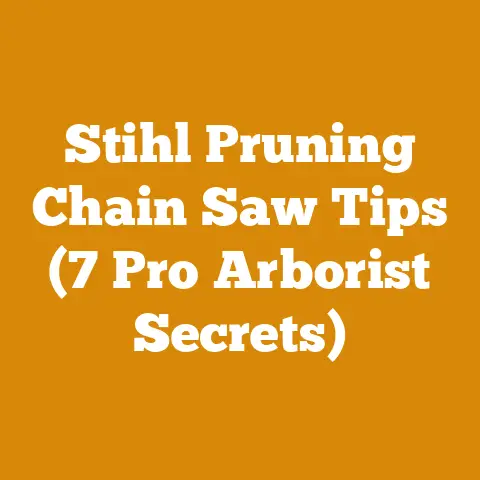Is Birch Wood Good for Burning? (5 Pro Tips for Efficient Firewood)
Blending styles in firewood selection, much like blending grapes for a fine wine, is an art. Some folks swear by a single type of wood, while others, myself included, believe in a mix to achieve the perfect burn. Before we dive into whether birch wood is good for burning, let’s set the stage: understanding firewood, its properties, and how to get the most out of it.
Is Birch Wood Good for Burning? (5 Pro Tips for Efficient Firewood)
Birch wood, with its distinctive bark and appealing aroma, often finds itself in the firewood discussion. But is it truly a top-tier choice? The answer, like most things in life, is nuanced. Let’s break it down.
Understanding Birch Wood: Species and Characteristics
Birch is a genus of trees and shrubs encompassing several species, including white birch (paper birch), yellow birch, and sweet birch. These species vary slightly in density and burning characteristics, but they share some common traits.
- Density: Birch is considered a medium-density hardwood. This means it burns hotter and longer than softwoods like pine or fir, but not as long or hot as dense hardwoods like oak or hickory.
- Resin Content: Birch tends to have a lower resin content than softwoods, making it less prone to sparking and popping – a definite advantage for indoor fireplaces.
- Moisture Content: Freshly cut birch can have high moisture content, which needs to be addressed through proper seasoning (drying).
- Aroma: Birch is known for its pleasant, slightly sweet aroma when burned, adding to the ambiance of a fire.
The Pros and Cons of Burning Birch
Let’s weigh the advantages and disadvantages of using birch as firewood.
Pros:
- Easy to Ignite: Birch is relatively easy to light, even when not perfectly seasoned. The papery bark acts as excellent kindling.
- Good Heat Output: While not the hottest burning wood, birch provides a respectable amount of heat, suitable for many heating needs.
- Pleasant Aroma: As mentioned, the fragrance is a definite plus, especially for indoor fires.
- Relatively Clean Burning: Compared to some softwoods, birch produces less smoke and creosote buildup when properly seasoned.
Cons:
- Shorter Burn Time: Compared to denser hardwoods, birch burns more quickly, requiring more frequent refueling.
- Rot Susceptibility: Birch is prone to rot, especially if left in contact with the ground. Proper storage is crucial.
- Smoke Potential: Unseasoned birch can produce significant smoke, negating the “clean burning” advantage.
Pro Tip #1: Seasoning Birch – The Key to Success
Seasoning, the process of drying wood, is critical for birch. Freshly cut birch can have a moisture content of 50% or higher. The goal is to reduce this to below 20% for efficient burning. Here’s how:
- Split the Wood: Splitting birch exposes more surface area, accelerating the drying process.
- Stack Properly: Stack the wood in a single row, off the ground, with plenty of air circulation. Crisscrossing the ends of the rows helps with stability and airflow.
- Sun and Wind: Choose a sunny, windy location for your woodpile. Sunlight helps evaporate moisture, and wind carries it away.
- Time is Your Friend: Birch typically needs at least 6-12 months of seasoning, depending on your climate. In drier climates, it might dry faster. In humid climates, it will take longer. I’ve found that in my location (Midwest USA), 18 months is ideal for birch.
- Moisture Meter: Invest in a moisture meter. They’re relatively inexpensive and will give you an accurate reading of the wood’s moisture content. Aim for below 20%.
Data Point: Studies show that properly seasoned firewood produces up to 50% more heat than unseasoned wood and significantly reduces creosote buildup.
Personal Anecdote: I once tried burning birch that I thought was seasoned. It smoked like a chimney and barely produced any heat.
Pro Tip #2: Blending Birch with Other Firewood
Birch shines when blended with other types of firewood. Its easy ignition and good heat output make it an excellent starter wood. Here are some effective blending strategies:
- Birch and Oak: Use birch to get the fire going quickly, then add oak for long-lasting heat. Oak is a dense hardwood that burns slowly and steadily.
- Birch and Maple: Maple is another good option for sustained heat. It’s denser than birch but not as dense as oak.
- Birch and Cherry: Cherry wood has a pleasant aroma similar to birch but burns a bit longer.
- Birch and Pine (with Caution): If you have pine available, you can use it sparingly in combination with birch, but be mindful of the increased sparking and creosote potential.
Cost Considerations: The cost of different types of firewood varies by region. In my area, oak is typically the most expensive, followed by maple, then birch. Pine is usually the cheapest. Adjust your blending strategy based on cost and availability.
Data Point: According to the U.S. Energy Information Administration, the average price of firewood in the United States ranges from $200 to $400 per cord, depending on the type of wood and location. Prices can be significantly higher in urban areas or during peak demand periods.
Case Study: A local firewood supplier I know blends birch, maple, and oak in a 2:2:1 ratio. He claims this provides the best combination of easy ignition, sustained heat, and customer satisfaction.
Pro Tip #3: Proper Storage is Paramount
As mentioned earlier, birch is susceptible to rot. Proper storage is essential to keep it dry and prevent decay.
- Elevated Storage: Store the wood off the ground, ideally on pallets or racks. This allows for air circulation underneath the stack.
- Covered Storage: Cover the top of the woodpile with a tarp or shed roof to protect it from rain and snow. Leave the sides open for ventilation.
- Avoid Direct Contact with Soil: Don’t stack wood directly against a wall or fence, as this can trap moisture and promote rot.
- Inspect Regularly: Periodically inspect your woodpile for signs of rot or insect infestation. Remove any affected pieces.
Cost Considerations: Building a simple firewood shed can be a worthwhile investment to protect your wood supply. The cost will vary depending on the size and materials used. A basic shed can be built for a few hundred dollars, while a more elaborate structure could cost several thousand.
Personal Experience: I once lost a significant portion of my birch supply to rot because I stored it improperly. It was a costly mistake that taught me the importance of proper storage.
Pro Tip #4: Consider Birch Bark as Kindling
Birch bark is nature’s perfect kindling. It’s highly flammable, even when slightly damp, and it lights easily with a match or lighter.
- Harvest Responsibly: When harvesting birch bark, only take what you need and avoid stripping bark from living trees. Dead or fallen trees are the best source.
- Store Dry: Store the bark in a dry place to maintain its flammability.
- Use Sparingly: A little birch bark goes a long way. Don’t use too much, as it can produce a lot of smoke.
Data Point: Birch bark contains oils that make it naturally waterproof and flammable, even in wet conditions.
Ethical Consideration: Sustainable harvesting of birch bark is crucial. Avoid harming living trees and respect the environment.
Pro Tip #5: Understanding the Cost of Birch Firewood
The cost of birch firewood varies depending on location, availability, and supplier. Here’s a breakdown of the cost factors:
- Timber Purchase or Harvesting Costs: If you’re harvesting your own birch, factor in the cost of permits (if required), chainsaw fuel, and maintenance. If you’re purchasing timber, compare prices from different suppliers.
- Labor Costs: If you’re hiring someone to cut and split the wood, factor in their hourly rate or per-cord fee.
- Tool Costs: Chainsaws, axes, splitting mauls, and firewood processors all have associated costs. Factor in the initial purchase price, maintenance, and replacement parts.
- Transportation Costs: Transporting the wood from the harvesting site to your storage location can be a significant expense.
- Seasoning Time: While not a direct cost, the time it takes to season the wood represents an opportunity cost. You could be burning other types of firewood in the meantime.
Industry Benchmarks: As mentioned earlier, the average price of firewood in the United States ranges from $200 to $400 per cord. Birch typically falls within this range, but prices can fluctuate depending on local market conditions.
Cost Optimization:
- Harvest Your Own: If you have access to birch trees and the necessary equipment, harvesting your own firewood can save you money.
- Buy in Bulk: Purchasing firewood in larger quantities often results in a lower per-cord price.
- Season Your Own: Seasoning your own firewood can save you money compared to buying pre-seasoned wood.
- Maintain Your Tools: Regular maintenance of your chainsaws and other tools will extend their lifespan and prevent costly repairs.
Calculations and Formulas:
- Estimating Volume: To estimate the volume of a stack of firewood, use the following formula: Length x Width x Height. Divide by 128 to convert cubic feet to cords.
- Estimating Drying Time: The drying time for firewood depends on several factors, including wood type, moisture content, climate, and stacking method. A general rule of thumb is 6-12 months for hardwoods like birch.
Challenges Faced by Small-Scale Loggers and Firewood Suppliers:
- Competition: Small-scale loggers and firewood suppliers face competition from larger companies with greater resources.
- Regulations: Complying with environmental regulations and safety standards can be challenging and expensive.
- Market Fluctuations: Firewood prices can fluctuate depending on weather conditions and demand.
- Labor Shortages: Finding reliable labor can be difficult, especially during peak season.
Compelling Phrases and Actionable Takeaways:
- “Unlock the warmth and aroma of birch with these pro tips!”
- “Don’t let your firewood go to waste – proper seasoning is the key!”
- “Blend birch with other hardwoods for the ultimate fire experience.”
- “Protect your investment with proper storage.”
- “Harvest birch bark responsibly for natural kindling.”
- “Maximize your firewood budget with these cost optimization strategies.”
Next Steps:
- Assess your firewood needs and budget.
- Determine the availability and cost of birch in your area.
- Develop a seasoning and storage plan.
- Consider blending birch with other types of firewood.
- Harvest birch bark responsibly for kindling.
- Maintain your tools and equipment.
- Enjoy the warmth and aroma of a well-prepared birch fire!
Conclusion:
Is birch wood good for burning? Absolutely, when used correctly. By understanding its properties, following these pro tips, and managing your costs effectively, you can enjoy the benefits of birch firewood for years to come. Remember, it’s all about blending knowledge, experience, and a little bit of elbow grease to create the perfect fire. And who knows, maybe you’ll even develop your own signature firewood blend, just like my local supplier!






